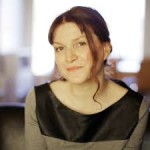I catch sight of the empty chair where Simon usually sits and sleeps. As recently as yesterday I watched him. His face, with sleep smoothing out all his facial features, I looked at the shoulders that seem shrunken, and the one leg he always stretches out a little, the hand with the wedding ring. When I left him this morning at the day care center, I felt an impulse to take his hand and feel it, I had the idea that if I held it exactly like that, it would be like an unbreakable bond, not skin and bone, but a different contact, that other contact, the one that has always been there. Before the silence. But I had problems holding his hand, I could not manage it because I was afraid of being seen or of seeing myself in that way. Perhaps it is only I who feels that gaze upon us.
It makes you feel naked, seeking out others and asking for help. Suddenly you are walking along unfamiliar corridors and opening doors. A group of people sits just waiting for you, but no one thinks there is anything wrong, at least anything unexpected. Only this silence.
I recall something Simon told me before he became old, before this irritating silence, that one of the earliest impressions he remembered clearly was the worn timber floor in the apartment where his family lay in hiding during the Second World War, how the rooms were tiny like boxes with doors, a playhouse where it was rarely possible to play. The walls of brown wood, the roof where he could lie looking up, with a feeling that everything was sinking or being sunk, toward them, inside them, through them, and everything linked to a feeling of guilt the origin of which he did not know, but that probably had a connection with his impatience at that time. The hiding place in a middle-sized city in Central Europe, a place where they stayed week after week, month after month. A place of safekeeping he could not endure and had begun to regard as a threat, since he seldom noticed anything of the actual danger. He quarreled with his parents, his younger brother, he was ten years old and hated being cooped up inside the tiny rooms. It felt as though the world had shriveled, as though it had contracted and would never contain or comprise anything other than these three small chambers, of a size hardly bigger than closets and the few people who lived in them, in addition to the helpers or wardens who came and went.
While they lived in this condition that has to be called imprisonment, Simon told me, they had to remain quiet. Silence was imposed on them, him, his brother, his parents and the two other people who stayed there. Their bodies had already adjusted to a subdued way of moving that never released its grip later, but became part of them, of their body language. They obtained a greater understanding of subtle changes in expression, becoming accustomed to observing others in that way, he noticed how his parents could look at each other as though they were able to transfer thoughts between them, nodding at what the other seemed to be saying; the adults could conduct what appeared to be lengthy conversations in this fashion, simply consisting of facial expressions, fleeting nods or other movements of the head or face, a raised eyebrow, a grimace. It was especially important at certain times of day when there were lots of other people moving around in the building, for example a physician whose office was directly below, who no longer had a large practice actually, but still received the occasional patient. At these times, that eventually stretched out to apply to the entire day, the night, they had really only each other to react to. Simon and his brother. The restrictions, being kept indoors, affected everything they did, everything felt constrained, everything they thought, drew, wrote, and tentatively played.
Read more this week in Little Star Weekly!


Merethe Lindstrøm is the author of several collections of short stories, novels, and a children’s book. She received the Norwegian Critics’s Prize for Literature and the Norwegian Youth Critics’s Prize for Days in the History of Silence, her first book to be translated into English. She lives in Oslo. Anne Bruce has previously translated the work of Wencke Mühleisen, Jørn Lier Horst, and Anne Holt.
Author photo by Ellen Lande Gossner